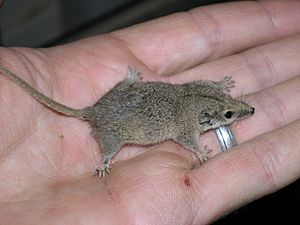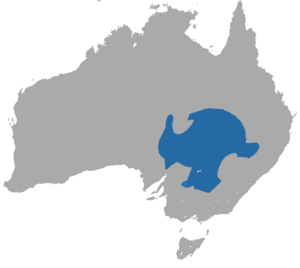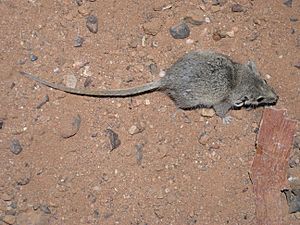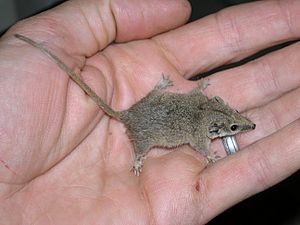Giles' planigale facts for kids
Quick facts for kids Paucident planigale |
|
|---|---|
 |
|
| Paucident planigale | |
| Conservation status | |
| Scientific classification | |
| Genus: |
Planigale
|
| Species: |
gilesi
|
 |
|
| Paucident planigale range | |
The paucident planigale (Planigale gilesi), also called Giles' planigale, is a tiny meat-eating marsupial. It belongs to a family of animals called Dasyuridae, which includes quolls and Tasmanian devils. This small creature is found in the dry, inland parts of Australia.
Contents
About the Paucident Planigale
The paucident planigale was first officially described in 1972. It was named Planigale gilesi to honor Ernest Giles, an explorer who traveled through Australia's deserts. These deserts are where this little animal lives. It is one of five different types of animals in the Planigale group.
What Does It Look Like?
The word "paucident" comes from Latin words meaning "few teeth." This planigale is special because it has only two premolars in each row of its teeth. Other planigales have three.
This tiny animal has a flat, triangular head and small, round ears. Its fur can be mid-grey to cinnamon brown, with a whitish belly. It is very light, weighing only 6 to 15 grams. Its body is about 6 to 8 centimeters long, and its tail is about 5.5 to 7 centimeters long.
The paucident planigale eats many small creatures. These include beetles, locusts, spiders, and other arthropods. Sometimes, it even eats small lizards or tiny mammals. It kills its prey with quick bites. Most paucident planigales live for less than two years in the wild. However, some have lived up to five years when cared for by humans.
Reproduction and Life Cycle
Paucident planigales usually breed from July to mid-January. Most babies are born in September. This breeding time happens during spring and summer, when there is more food available. This is similar to other marsupials that live in dry areas.
Female paucident planigales have a flat pouch covered in short, off-white fur. Inside the pouch, there are 12 teats, which are smooth and cream-colored. The pouch opening is small. A thin fold of skin covers the teats, holding them close to the female's body.
Young female planigales become ready to breed at about 5 months old. Their pouch develops quickly before their first babies are born. If they don't get pregnant right away, the pouch develops more slowly.
Male planigales are ready to breed at around 6.5 months old. Females make a soft "clucking" sound the night before they are ready to mate. Males will try to attract females about 24 hours before mating. Females might fight or make noises in response. Mating can last for 2.5 to 4 hours, and more than one male might mate with a female during this time. Males often fight over females who are ready to breed.
Females are ready to mate for 3 days, and their breeding cycle is 21 days long. Pregnancy lasts for about 15.5 days. On average, a female will have 6 babies in a litter. The tiny babies stay in their mother's pouch, attached to the teats, for 37 days. They continue to drink milk for about 75 days.
Where It Lives
The paucident planigale lives in the dry, inland parts of Australia. You can find it from Lake Eyre in South Australia to Moree in New South Wales. It also lives from Mildura in Victoria to the southwestern Northern Territory.
These animals often live in areas with cracked clay soils, like floodplains. The cracks in the ground give them shelter from bad weather.
Behavior
The paucident planigale is mostly active at night. During the day or when conditions are bad, it can go into a state of torpor. This is like a mini-hibernation that helps it save energy when it's not active.
This planigale also likes to bask in the sun. This is a special way for it to save energy, especially in winter. It is the smallest mammal known to sunbathe in the wild to reduce its energy needs. Basking helps it survive in harsh places where food can be hard to find. The paucident planigale searches for food among low plants, in soil cracks, and in leaf litter. It looks for invertebrates (like insects) and small vertebrates (like tiny lizards).
Threats to the Planigale
The paucident planigale has several predators. These include animals like foxes and feral cats that hunt for food. They can also be harmed by poisoning from cane toads.
Other threats include losing their habitat. This can happen from frequent fires that reduce ground cover. Disturbances to plants near water bodies and general damage to their living areas also threaten them.
Conservation Status
In the state of Victoria, the paucident planigale is listed as threatened under the Flora and Fauna Guarantee Act 1988. This means it needs protection in Victoria. However, across Australia, it is not considered threatened nationally. In Victoria, it only lives in a small area along the Murray River floodplain.
See also
 In Spanish: Ratón marsupial de Giles para niños
In Spanish: Ratón marsupial de Giles para niños




